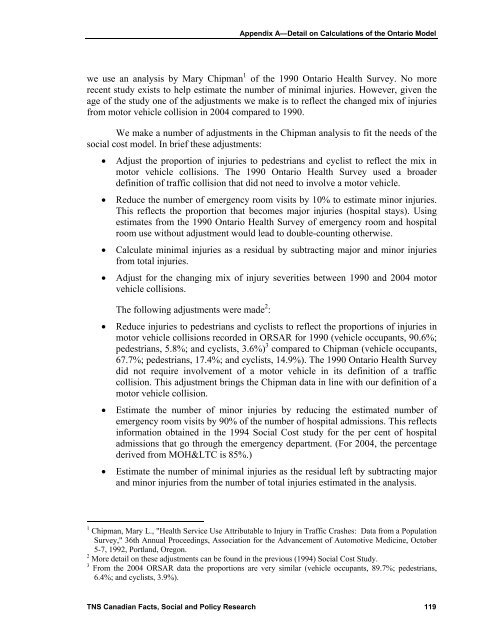Keith Vodden Dr. Douglas Smith - Transports Canada
Keith Vodden Dr. Douglas Smith - Transports Canada
Keith Vodden Dr. Douglas Smith - Transports Canada
Create successful ePaper yourself
Turn your PDF publications into a flip-book with our unique Google optimized e-Paper software.
Appendix A—Detail on Calculations of the Ontario Model<br />
we use an analysis by Mary Chipman 1 of the 1990 Ontario Health Survey. No more<br />
recent study exists to help estimate the number of minimal injuries. However, given the<br />
age of the study one of the adjustments we make is to reflect the changed mix of injuries<br />
from motor vehicle collision in 2004 compared to 1990.<br />
We make a number of adjustments in the Chipman analysis to fit the needs of the<br />
social cost model. In brief these adjustments:<br />
• Adjust the proportion of injuries to pedestrians and cyclist to reflect the mix in<br />
motor vehicle collisions. The 1990 Ontario Health Survey used a broader<br />
definition of traffic collision that did not need to involve a motor vehicle.<br />
• Reduce the number of emergency room visits by 10% to estimate minor injuries.<br />
This reflects the proportion that becomes major injuries (hospital stays). Using<br />
estimates from the 1990 Ontario Health Survey of emergency room and hospital<br />
room use without adjustment would lead to double-counting otherwise.<br />
• Calculate minimal injuries as a residual by subtracting major and minor injuries<br />
from total injuries.<br />
• Adjust for the changing mix of injury severities between 1990 and 2004 motor<br />
vehicle collisions.<br />
The following adjustments were made 2 :<br />
• Reduce injuries to pedestrians and cyclists to reflect the proportions of injuries in<br />
motor vehicle collisions recorded in ORSAR for 1990 (vehicle occupants, 90.6%;<br />
pedestrians, 5.8%; and cyclists, 3.6%) 3 compared to Chipman (vehicle occupants,<br />
67.7%; pedestrians, 17.4%; and cyclists, 14.9%). The 1990 Ontario Health Survey<br />
did not require involvement of a motor vehicle in its definition of a traffic<br />
collision. This adjustment brings the Chipman data in line with our definition of a<br />
motor vehicle collision.<br />
• Estimate the number of minor injuries by reducing the estimated number of<br />
emergency room visits by 90% of the number of hospital admissions. This reflects<br />
information obtained in the 1994 Social Cost study for the per cent of hospital<br />
admissions that go through the emergency department. (For 2004, the percentage<br />
derived from MOH<C is 85%.)<br />
• Estimate the number of minimal injuries as the residual left by subtracting major<br />
and minor injuries from the number of total injuries estimated in the analysis.<br />
1 Chipman, Mary L., "Health Service Use Attributable to Injury in Traffic Crashes: Data from a Population<br />
Survey," 36th Annual Proceedings, Association for the Advancement of Automotive Medicine, October<br />
5-7, 1992, Portland, Oregon.<br />
2 More detail on these adjustments can be found in the previous (1994) Social Cost Study.<br />
3 From the 2004 ORSAR data the proportions are very similar (vehicle occupants, 89.7%; pedestrians,<br />
6.4%; and cyclists, 3.9%).<br />
TNS Canadian Facts, Social and Policy Research 119
















